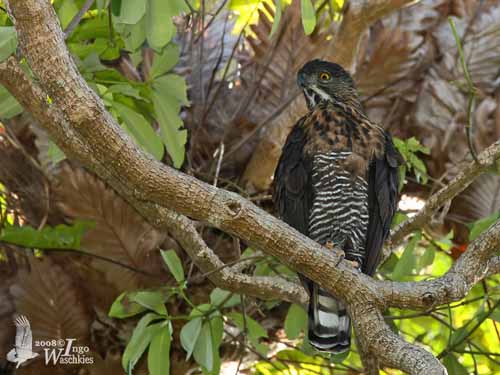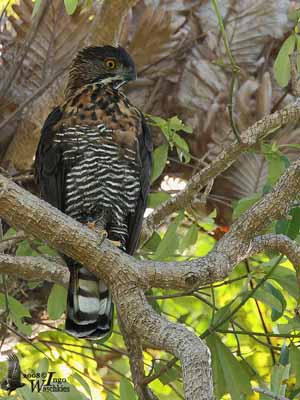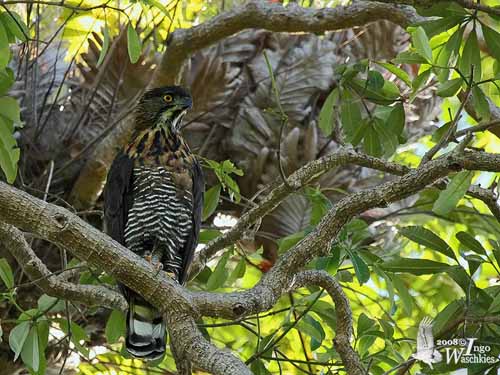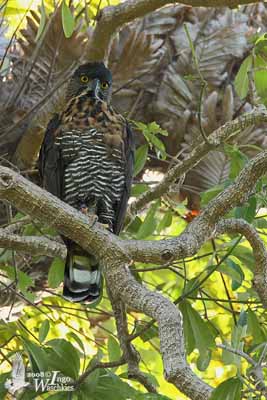
Fr: Aigle des Célèbes
All : Celebesadler
Esp: Águila-azor de Célebes
Ital: Spizaeto di Sulawesi
Nd: Celebes-kuifarend
Sd: Sulawesiörn
Photographer:
Ingo Waschkies
My bird pictures on Pbase
Text by Nicole Bouglouan
Sources:
HANDBOOK OF THE BIRDS OF THE WORLD Vol 2 by Josep del Hoyo-Andrew Elliot-Jordi Sargatal - Lynx Edicions - ISBN: 8487334156
RAPTORS OF THE WORLD by James Ferguson-Lees et David Christie - Helm Identification Guides – ISBN: 0713680261
L’ENCYCLOPEDIE MONDIALE DES OISEAUX - Dr Christopher M. Perrins - BORDAS - ISBN: 2040185607
BirdLife International (BirdLife International)
Wikipedia, the free encyclopaedia
XENO-CANTO – Sharing Birds sounds from around the world
Sulawesi Hawk-Eagle
Nisaetus lanceolatus
Accipitriforme Order – Accipitridae Family
BIOMETRICS:
Length: 56-64 cm
DESCRIPTION:
The Sulawesi Hawk-Eagle is endemic to Sulawesi and close islands. This uncommon and very local raptor is an inhabitant of the rainforest.
The adult male has blackish-brown upperparts with paler brown feathers’ edges. The tail is brownish-grey or grey with 3-4 conspicuous black bars. The subterminal black band is broader than others. The uppertail-coverts are variably white-tipped.
On the underparts, the throat is white with black median stripe, and bordered on each side by a black malar stripe. The breast is rufous, boldly streaked black. The rest of the underparts are white, heavily barred blackish-brown, including thighs and tarsi. The underwing is blackish-brown.

On the head, crown and short crest are black. Cheeks and collar are blackish with narrow, whitish streaks on cheeks, and rufous streaks on the rear of the head sides, nape and hind neck.
The hooked bill is blackish with black cere. The eyes are golden-yellow with bare greyish-brown lores. The feathered legs and feet are yellow with black claws.
Both sexes are similar, but the female is larger than the male.
The juvenile has dark brown back and wings with paler brown feathers’ edges and whitish bases. The tail is rather dark grey-brown with 5-6 blackish bars.
Head, upper mantle and underparts are white, with several brown streaks on upper mantle, but also on crown, nape and breast, but more irregular. The flanks may sometimes show dark barring. The eyes are pale brown to yellow. The cere is blackish-grey.
The young birds of 2d and 3d years are pale below with more rufous and dark spots on the breast, and barred belly.

VOICE:
The Sulawesi Hawk-Eagle utters a kind of prolonged laughing call, first accelerating and then, descending towards the end.
We can also hear irregular phrases “piw-piuu, piw-piuu, piw WE we wea, piw WE we wea” given in series.
HABITAT:
The Sulawesi Hawk-Eagle occurs in primary and old secondary forest, as well in lowlands as in mountains, with open areas and clearings providing it hunting areas.
This species is found from sea-level up to 2000 metres of elevation, but more usually between 250 and 1500 metres.
RANGE:
The Sulawesi Hawk-Eagle occurs in Indonesia. The species is endemic to Sulawesi and the close islands of Buton, Muna, Banggai and Sula Islands.
BEHAVIOUR:
The behaviour of the Sulawesi Hawk-Eagle is poorly known. However, it probably hunts from concealed perches in cover like other eagles “Spizaetus”, and swoops down onto the prey on the ground.
It takes mainly small and medium-sized birds, small mammals and some snakes and lizards. It is also known to take sometimes domestic chicken.
It may soar low over the tree tops where it snatches preys.
The Sulawesi Hawk-Eagle is usually seen solitary or in pairs. The aerial displays include circling above the territory and in the vicinity of the nest-site.
This species is sedentary in its range.

FLIGHT:
The Sulawesi Hawk-Eagle in flight appears as medium-sized raptor, with rather short and rounded wings, and rounded tail.
It flies from perch to perch with rapid wing-beats.
REPRODUCTION:
Breeding season occurs between May and August.
The Sulawesi Hawk-Eagle builds a stick nest on large horizontal branch in huge tree in forest, often in epiphytes, at about 20 metres above the ground.
The clutch size is probably of a single egg. The nesting behaviour of this species is unknown, but recently fledged young birds have been observed in August. That may suggest that the incubation lasts about 40 to 50 days. The young remain at nest for several weeks before to fledge and to be able to fly.

DIET:
The Sulawesi Hawk-Eagle hunts primarily for small and medium-sized birds, small mammals, snakes and lizards. It also takes sometimes domestic fowl. It hunts from concealed perch and swoops down onto its prey.
PROTECTION / THREATS / STATUS:
The Sulawesi Hawk-Eagle was evaluated as Near Threatened, but several records suggest that this bird is not so uncommon but may be locally common according to the regions. It is common in Dumoga-Bone National Park in N Sulawesi.
The species is threatened by disturbances and deforestation. The latter is the main threat for this forest species.
Currently, the Sulawesi Hawk-Eagle is evaluated as Least Concern by Birdlife International.